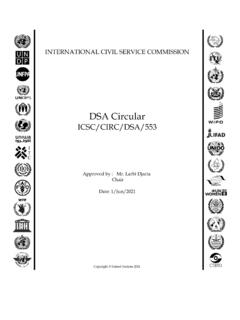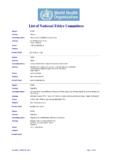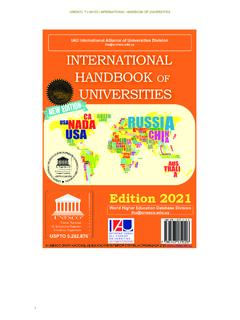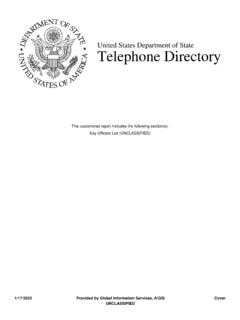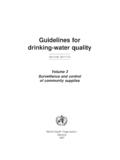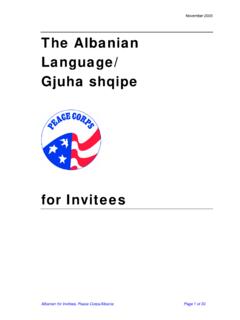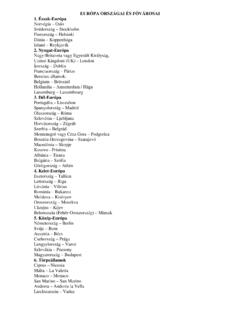Transcription of The Cold War Era - NCERT
1 OVERVIEWThis chapter provides a backdropto the entire book. The end of theCold War is usually seen as thebeginning of the contemporary erain world politics which is thesubject matter of this book. It is,therefore, appropriate that webegin the story with a discussionof the cold War. The chapter showshow the dominance of twosuperpowers, the United States ofAmerica and the Soviet Union,was central to the cold War. Ittracks the various arenas of theCold War in different parts of theworld. The chapter views the Non-Aligned Movement (NAM) as achallenge to the dominance of thetwo superpowers and describesthe attempts by the non-alignedcountries to establish a NewInternational Economic Order(NIEO) as a means of attainingeconomic development andpolitical independence. Itconcludes with an assessment ofIndia s role in NAM and asks howsuccessful the policy of non-alignment has been in protectingIndia s 1 The cold War EraThe end of the Second World War led to the rise of two majorcentres of power.
2 The two pictures above symbolise thevictory of the US and the USSR in the Second World American soldiers raising the US flag during the Battle ofIwo Jima, Japan, on 23 February 1945 Credit: Raising the Flag on Iwo Jima,Photograph by Joe Rosenthal/The Associated Press2. Soviet soldiers raising the USSR flag on the Reichstagbuilding in Berlin, Germany, in May 1945 Credit: Reichstag flag, Photograph by Yevgeny Khaldei/TASS2021 22 Contemporary World Politics2 CUBAN MISSILE CRISISIn April 1961, the leaders of theUnion of Soviet Socialist Republics(USSR) were worried that theUnited States of America (USA)would invade communist-ruledCuba and overthrow Fidel Castro,the president of the small islandnation off the coast of the UnitedStates. Cuba was an ally of theSoviet Union and received bothdiplomatic and financial aid fromit. Nikita Khrushchev, the leaderof the Soviet Union, decided toconvert Cuba into a Russian 1962, he placed nuclear missilesin Cuba.
3 The installation of theseweapons put the US, for the firsttime, under fire from close rangeand nearly doubled the number ofbases or cities in the Americanmainland which could bethreatened by the weeks after the SovietUnion had placed the nuclearweapons in Cuba, the Americansbecame aware of it. The USPresident, John F. Kennedy, andhis advisers were reluctant to doanything that might lead tofull-scale nuclear war betweenthe two countries, but they weredetermined to get Khrushchev toremove the missiles and nuclearweapons from Cuba. Kennedyordered American warships tointercept any Soviet shipsheading to Cuba as a way ofwarning the USSR of hisseriousness. A clash seemedimminent in what came to beknown as the Cuban MissileCrisis. The prospects of thisWe are on a world tour! Will meet you in different countries. Feels goodto be around where events have showing the range of the nuclear missiles under constructionin Cuba, used during the secret meetings on the Cuban missile crisisSource: John F.
4 Kennedy Presidential Library & Museum2021 22 The cold War Era3clash made the whole worldnervous, for it would have beenno ordinary war. Eventually, tothe world s great relief, bothsides decided to avoid war. TheSoviet ships slowed down andturned Cuban Missile Crisis wasa high point of what came to beknown as the cold War. The ColdWar referred to the competition,the tensions and a series ofconfrontations between theUnited States and Soviet Union,backed by their respective , however, it neverescalated into a hot war , that is,a full-scale war between these twopowers. There were wars invarious regions, with the twopowers and their allies involvedin warfare and in supportingregional allies, but at least theworld avoided another global cold War was notsimply a matter of powerrivalries, of military alliances,and of the balance of were accompanied by areal ideological conflict as well,a difference over the best andthe most appropriate way oforganising political, economic,and social life all over the western alliance, headed bythe US, represented theideology of liberal democracyand capitalism while theeastern alliance, headed by theSoviet Union, was committed tothe ideology of socialism andcommunism.
5 You have alreadystudied these ideologies inClass IS THE cold WAR?The end of the Second World Waris a landmark in contemporaryworld politics. In 1945, the AlliedForces, led by the US, SovietUnion, Britain and Francedefeated the Axis Powers led byGermany, Italy and Japan, endingthe Second World War (1939-1945). The war had involvedalmost all the major powers of theworld and spread out to regionsoutside Europe includingSoutheast Asia, China, Burma(now Myanmar) and parts ofIndia s northeast. The wardevastated the world in terms ofloss of human lives and civilianproperty. The First World War hadearlier shaken the world between1914 and end of the Second WorldWar was also the beginning of theCold War. The world war endedwhen the United States droppedtwo atomic bombs on theJapanese cities of Hiroshima andNagasaki in August 1945, causingJapan to surrender.
6 Critics of theUS decision to drop the bombshave argued that the US knew thatJapan was about to surrender andthat it was unnecessary to dropthe bombs. They suggest that theUS action was intended to stop theSoviet Union from making militaryand political gains in Asia andelsewhere and to show Moscowthat the United States wassupreme. US supporters haveargued that the dropping of theatomic bombs was necessary toend the war quickly and to stopSo near yet so far!I can't believe thatCuba survived as acommunist countryfor so long despitebeing located soclose to the US. Justlook at the 22 Contemporary World Politics4further loss of American and Alliedlives. Whatever the motives, theconsequence of the end of theSecond World War was the rise oftwo new powers on the global the defeat of Germany andJapan, the devastation of Europeand in many other parts of theworld, the United States and theSoviet Union became the greatestpowers in the world with the abilityto influence events anywhere the cold War was anoutcome of the emergence of theUS and the USSR as twosuperpowers rival to each other,it was also rooted in theunderstanding that the destructioncaused by the use of atom bombsis too costly for any country tobear.
7 The logic is simple yetpowerful. When two rival powersare in possession of nuclearweapons capable of inflicting deathand destruction unacceptable toeach other, a full-fledged war isunlikely. In spite of provocations,neither side would want to risk warsince no political gains wouldjustify the destruction of the event of a nuclear war,both sides will be so badly harmedthat it will be impossible to declareone side or the other as the if one of them tries to attackand disable the nuclear weaponsof its rival, the other would still beleft with enough nuclear weaponsto inflict unacceptable is called the logic of deterrence : both sides have thecapacity to retaliate against anattack and to cause so muchdestruction that neither can affordto initiate war. Thus, the cold War in spite of being an intense formof rivalry between great powers remained a cold and not hot orshooting war.
8 The deterrencerelationship prevents war but notthe rivalry between the main militaryfeatures of the cold War. The twosuperpowers and the countries inthe rival blocs led by thesuperpowers were expected tobehave as rational andresponsible actors. They were tobe rational and responsible in thesense that they understood therisks in fighting wars that mightinvolve the two two superpowers and theblocs led by them are in adeterrence relationship, fightingwars will be massively pictures depict the destructioncaused by the bombs dropped by theUS on Hiroshima (the bomb was code-named Little Boy ) and Nagasaki(code-named Fat Man ). Yet, thesebombs were very small in theirdestructive capacity (measured interms of kiloton yield) as compared tothe nuclear bombs that were to beavailable in the stockpiles assembled bythe superpowers.
9 The yield of Little Boyand Fat Man were 15 and 21 kilotonsrespectively. By the early 1950s the USand the USSR were already makingthermonuclear weapons that had ayield between 10 and 15 thousandkilotons. In other words, these bombswere a thousand times more destructivethan the bombs used in Hiroshima andNagasaki. During much of the cold War,both the superpowers possessedthousands of such weapons. Justimagine the extent of destruction thatthese could cause all over the 22 The cold War Era5 Map showing the way Europe was divided into rival alliances during the cold War1. Identify threecountries from eachof the rival Look at the mapof the EuropeanUnion in Chapter 4and identify fourcountries that werepart of the WarsawPact and nowbelong to the By comparing thismap with that ofthe European Unionmap, identify threenew countries thatcame up in thepost- cold , therefore, meantbeing restrained and avoiding therisk of another world war.
10 In thissense the cold War managed toensure human EMERGENCE OFTWO POWER BLOCSThe two superpowers were keenon expanding their spheres ofinfluence in different parts of theworld. In a world sharply dividedbetween the two alliance systems,a state was supposed to remaintied to its protective superpowerto limit the influence of the othersuperpower and its smaller states in thealliances used the link to thesuperpowers for their ownpurposes. They got the promise ofprotection, weapons, andeconomic aid against their localrivals, mostly regional neighbourswith whom they had rivalries. Thealliance systems led by thetwo superpowers, therefore,threatened to divide the entireworld into two camps. Thisdivision happened first in countries of western Europesided with the US and those ofeastern Europe joined the Sovietcamp. That is why these were alsocalled the western and the eastern HagueBonnEASTGERMANYB erlinPOLANDW arsaw IRELANDD ublinBRITAINN orthSeaNATO MembersWarsaw Pact MembersOther Communist NationsOthersNORWAYOsloSWEDENS tockholmDENMARKC openhagenHelsinkiFINLANDM oscowUSSR2021 22 Contemporary World Politics6In the followingcolumn, writethe names ofthree countries,which belong to:Capitalist Bloc_____Communist Bloc_____Non-AlignedMovement_____The western alliance wasformalised into an organisation,the North Atlantic TreatyOrganisation (NATO), which cameinto existence in April 1949.










